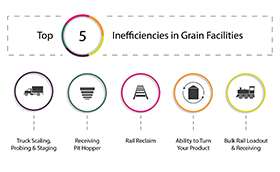VAA News | May 4, 2017
Top Five Inefficiencies in Grain Facilities

These common issues are often overlooked at grain facilities. Addressing problems with the right solutions can make your operation more efficient.

1. Truck Scaling, Probing and Staging
Problem: If you can’t get trucks in and out of your site fast enough the pit will sit idle.
Improvements:
- Make sure there are enough scales to service the facility.
- Have enough room between the truck probe and the inbound scale and enough room between the inbound scale and the receiving pit. This allows trucks waiting for test results to not tie up the receiving pit, probe or scale for others.

2. Receiving Pit Hopper
Problem: An undersized receiving hopper can limit the speed at which materials are brought in. Any time the hopper is sitting empty is lost capacity.
Improvements:
- Size the hopper to hold enough material so it is not empty when switching from one truck to the next.
- Put in larger receiving grates and/or hoppers. This allows trucks to open multiple discharge gates at one time.

3. Rail Reclaim
Problem: Rail cars are occasionally overfilled in the loading process. Without a quick and easy unload system, this can slow down the train filling process and take longer to get a train off site.
Improvements:
- Having a portable unloader that slides under the rail car to unload the product to a truck is a fairly simple way to handle reclaim spilled product at an existing elevator.
- In new elevators, put a reclaim pit under the rail. Depending on the site layout, doing this may also make it easy to add an extra truck receiving pit on the same conveyor for use during harvest, or if the main receiving pit is out of service.

4. Ability to Turn Your Product
Problem: When grain storage is an ancillary part of a process facility, often times the ability to move product from one bin to another is not available, which can make cleaning out a bin more difficult.
Improvements:
- By adding two-way valves at the head of the reclaim conveyor or the head of the reclaim leg, it may be possible to send the reclaimed product back to the distribution system. With certain products, depending on the availability of aeration in the bins or the moisture level, this will provide the ability to turn the bins to help prevent the product from setting up.

5. Bulk Rail Loadout and Receiving
Problem: With decreasing time allotted by the railroads for shuttle train loading / unloading, many facilities do not have the ability to get trains processed fast enough.
Improvements:
- Loop tracks are usually the easiest way to manage shuttle trains, as the train can be left in one continuous string; however, this type of track requires more land. If land is not available for a loop, consider a ladder configuration. This will almost always require breaking the shuttle into multiple strings for switching operations. If a train needs to be broken into multiple segments to be loaded, try to keep the train in as few segments as possible, and have as little travel time as possible between switching strings.
- Consider the track and rail car movement on the site when sizing the loading equipment. Facilities where trains need to be split into multiple strings will need faster loading equipment to fill a train in at the same speed as a loop track facility.
- Make sure the upper and lower garners on the scale system are sized large enough. This will prevent frequent stops of all the reclaim equipment when switching between rail cars – keep the system moving.
Interested in learning more about improving your grain facility? Talk to Bernie Jansen, Doug Rohkohl and Paul Murphy who regularly serve VAA’s Agribusiness clients.
Share with a Friend
Recent Posts
Let's connect.
Whether you need a new or expanded facility, a process designed or debottlenecked, life safety or structural analysis… VAA can help you grow.






